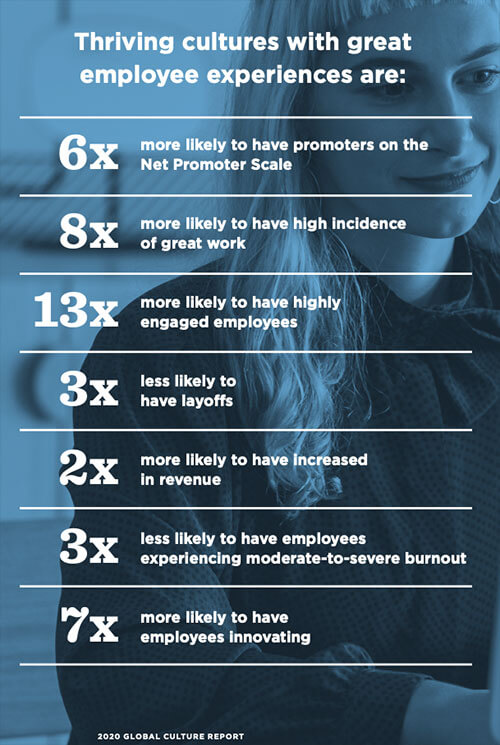When setting up your digital workplace, how can business leaders provide good employee experiences?
78% of IT leaders say digital employee experience related projects are now of a much higher priority as compared to the last two years.
In Deloitte’s annual Global Human Capital Trends survey, 80% of executives rate employee experience as important as or more important than customer experience (CX).
What experiences make employees choose a certain digital experience platform over another? What options make everyday work easier for them?
Before we get into that, what is the digital employee experience really and how does it relate to the importance of culture and morale in the workplace?
Defining Digital Employee Experience
At a glance:
“The sum total of the digital interactions between a staff member and their organisation.”
– James Robertson, Digital Workplace Expert
Often referred to as DEX (Digital employee experience), at its core, it’s about making all the interactions that employees have within a business a positive experience.
When combined, DEX encapsulates the elements of employee experience and how they actually work and interact with a given technology.
These interactions include:
- Emotional – related to motivation and fullfilment
- Cultural – related to activities within the business for employee engagement
- Physical – related to facilitation of productivity with tools, devices, and systems used
Ultimately, these contribute to employee’s perceived value of the workplace.
According to a VMware global survey of 6,400 employees, digital employee experience is linked to business success in such a way that it directly contributes to rate of growth, employee sentiment, and talent recruitment.
Need more proof that the employee experience is beneficial for organisations? The OC Tanner Global Culture Study found that:

Challenges with DEX
With reliance on digital tools, more and more organisations are focusing on improving the impact of digital workplace trends on its employees. But with that intent, there are certain challenges that must be dealt with.
What are the top challenges faced when implementing DEX?
No Clear Vision or Strategy
It all starts with a clear vision and strategy. Otherwise, instead of improving the digital experience, you might just be forced towards going back to traditional practices - with confusing processes, tools that aren't valuable and strained relationships between your people.
Once a clear vision is set on what aspects (and why) you want to improve in terms of DEX, you can build out a strategy to achieve this. This will provide a holistic view of your DEX implementation - how the people, process and tools will interact and be affected, as well as how to determine effectiveness.
Part of this strategy should be ensuring you create a culture that embraces digital transformation. Employees need to not only accept this digital workplace you are trying to build, but be equipped with the skills and training to leverage it appropriately.
Technology Limitations
What is DEX without technical capabilities? Digital transformation is a key component of DEX. Factors like disconnected tools, non-automated systems, or inaccessibility of files and apps only hinder DEX optimisation. This is exacerbated by remote working challenges that need to be overcome to boost employee experience.
Making sure your current technology and tools are provide a seamless experience for employees, and ensuring that their restrictions (if any) don’t affect your progress, is crucial.
No Ownership
Improving DEX comes with the need to implement it in the same way you would implement tactics for improving customer experience - there needs to be ownership over the strategy and execution. Often it is the IT teams, digital team, internal communications teams or intranet teams.
There needs to be a person or team in charge of ensuring a strategy is put in place, and executed in a timely and effective manner by other teams according to the strategy.
How to Get Started
Implementing a successful digital employee experience is built on a concrete plan, in line with business goals and visions. How do you prepare your organisation for employee experience changes? DEX is not a one-size-fits-all process, it is a unique approach and needs the following to get started:
Decide on Your DEX Team
A leadership team becomes the foundation of a great digital employee experience. These key members will design systems and develop strategies that will lead employees to feel comfortable when using digital tools.
Remember that different departments have different priorities for employees. You might have internal communications or HR teams lead your DEX projects, as their goals are to promote employee productivity and increase engagement. On the other hand, the IT teams have a good understanding of how the wider technological ecosystem employees require.
And as with any projects that require large scale changes to the organisation, having buy-in from the executive team is key.
For these reasons, the ideal scenario is to put together a cross-departmental team, who collectively have a good understanding of what is required to improve DEX from different perspectives across the organisation.
Understand Your Employees
What do employees need in their ideal digital workplace? Think about their communication needs and preferences, where they work and how they interact with each other and the organisation. Remote employees will have different needs to office based employees. For example, frontline employees need a platform that is accessible from any location and on their personal devices. Engage in a range of research methods from automated surveys to one-on-one interviews and observations.
As Sam Marshall of Clearbox Consulting puts it, organisations need to reduce the ‘digital drag’ by providing employees fluidity, simplicity, progress, and meaning from their digital workplaces.
As such, understanding why employee experience matters to employees becomes the priority. Critical factors include providing employees with a variety of tools that heighten productivity and giving access to a seamless technology experience to increase workforce engagement.
Prioritise
As an internal system, DEX becomes indispensable when accessibility and implementation are prioritised.
This will enable you implement changes in iterations and phases, which is both helpful for budgetary reasons but also for the employees. This approach avoids overwhelming employees with too much change at once and enables you to measure the effectiveness and adjust your DEX strategy as needed.
Keep Gathering Feedback
DEX is not a set-and-forget system. It is an ongoing, progressive process that needs updating and upgrading. When technology evolves, DEX evolves too, shaping employee experience as well.
Keep gathering feedback on employees so that everyone is up to speed.
Intranets at Play
There’s good digital employee experience. And then, there’s great digital employee experience. The former focuses on introducing tools and processes to assist employees, while the latter emphasises how these tools can be delivered in a more effective way.
Intranets offer a range of key benefits in the workplace that assist with improving DEX. Moreover, intranet play a significant role in boosting employee experience in times of a crisis or large changes within the organisation, among other significant financial and business gains.
How do intranets help build a great DEX?
1. Gives Employees Resources They Need
Intranets are a centralised repository of information and tools that employees need to get their jobs done. With a seamless user experience, your intranet can improve and solve several business processes across different departments.
You can utilise the intranet’s features to assist with DEX:
- Document management, including policies and procedures
- Knowledge bases
- Centralised interface, integrated to third party systems
- Forms and workflows
- Online training courses and relevant resources
- Onboarding hub as part of the intranet
2. Aligns Their Values With the Organisation
DEX improves with an intranet’s ability to streamline key activities that promote business values and culture. For example, if business leaders want to share company success or information, intranet's have the capability to do so, while also personalising the content so it is only seen by a group of employees such as those based on a particular country. This information is easily searchable and filtered on the intranet if employees want to reference it at a later date.
What key activities can you engage in with the use of the intranet?
- Highlights organisation goals, mission, strategy and plan
- Publish news that generate positivity and are value-oriented
- Get leaders to communicate ideas and share feedback
- Post goals, challenges, and success stories
Related reading: [Blog post] How to Cultivate a Positive Culture With Your Remote Workforce
3. Promotes an Employee-focused Approach
Employees are faced with multiple systems and tools that make working in the digital workplace a complex process. According to Bluewolf, 70% of workers have to enter the same data into multiple systems to get their jobs done, which can be quite inconvenient. You can overcome this with the use of intranets.
With the intranet, you have an all-in-one unified engagement and information platform. When set up correctly, it can simplify daily work, foster rich engagement and in turn drive more productivity.
Most intranets offer built-in integration to third party tools such as Office 365, SharePoint, Salesforce and other popular tools, while also providing APIs to build custom integrations. For example, you could use Yammer as your main instant messaging tool, with a Yammer thread for HR questions. Then embed it onto the HR section of your intranet. In this way, you have one centralised interface for all information and communication related to HR.
4. Improves Internal Communications for Everyone
Internal communications in your workforce plays a big role in employee engagement and overall business health. In a blog by Smarp, employee engagement comes first in the list of benefits of good communication. With an intranet at hand, information sharing, feedback and correspondence is made convenient for all employees.
How does your intranet help in internal communications?
- Allows knowledge-sharing and management where you and employees can discuss and share information and ideas
- Creates a corporate directory or Skill Hub for employees to upgrade and share skills
- Values employees through recognition boards where individual and team efforts are rewarded
- Facilitates training where employees get continuous support through online classes
- Engages employees through surveys, polls, and Q&A for feedback and two-way communication
5. Rewards Employees So They Feel Appreciated and Valued
A recognition and rewards system is essential for holistic employee experience. Recognised employees are happy employees. As Gallup puts it, workplace recognition motivates, provides a sense of accomplishment and makes employees feel valued for their work. Even without the ideal face-to-face recognition, the intranet can do wonders in the digital workplace.
What can intranets do for this?
- Share news and features of individual or team progress
- Provide suggestions and tips on health and well-being
- Enable submission of nominations on awards for outstanding employees
- Provides a central interface for your formal rewards program
- Enables you to highlight the winners e.g. on a rewards widget on the intranet homepage
Key Points to Remember
An intranet enables resources and tools to be accessible anywhere from any device. As remote working has become a prominent option these days, it’s good for your employees to have the convenience of anywhere-access.
To optimise your intranet for great digital employee experience, you must ensure that design, structure, and navigation capabilities are intuitive for employees to use - along with of course, a solid intranet strategy and plan.
With great digital employee experience management, the workplace is streamlined, business processes are more efficient, employees are more satisfied and engaged, employee retention is higher and your organisation’s longevity is more secure.
Next Steps
During this period of uncertainty sweeping the world, creating an exceptional employee experience can seem like an uphill battle.
In this webinar video, we explore the critical shifts in workforce management needed to help staff adapt, as well as how you can keep staff engaged, empowered and mentally connected.
